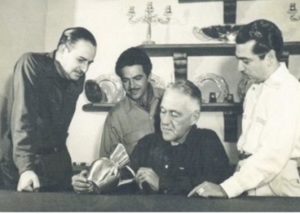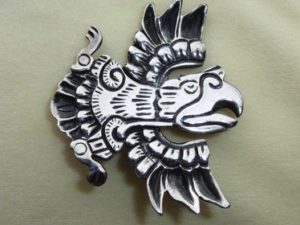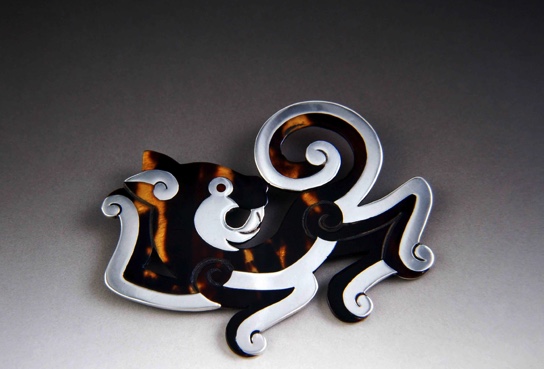
William Spratling, the man who made Taxco jewelry famous, was an unlikely father of Mexican silver. He wasn’t Mexican, and he had not studied jewelry making. The celebrated jewelry artist grew up in Auburn, Ala. and studied architecture at the Alabama Polytechnic Institute, which later became Auburn University where he would go on to teach. How he came to jewelry design is a tale of serendipity and passion for Mexico.
Spratling initially supported himself by teaching, but he had an artist’s heart and ran in creative circles.. He taught architecture at Tulane University where he shared an apartment with famous novelist William Faulkner. In the late 1920s, he spent summers lecturing at the National University of Mexico in Mexico City and quickly immersed himself in the Mexican arts scene. He became friends with muralist Diego Rivera and even organized an exhibition for Rivera at the Metropolitan Museum of Art in New York.
A Silver Revival
While studying Mexico’s baroque architecture, Spratling ventured to the colonial town of Taxco in the mountains of Guerrero state between Mexico City and Acapulco. In 1929 he bought at house there and planned to cloister away and finally write a book. But he became so enamored with the local culture that his focus shifted to igniting an arts movement using the area’s silver. Taxco had a long history of silver mining going back hundred of years, but after the Mexican War for Independence in the 1800s, mines were left dormant.

Spratling encouraged the locals to reopen the mines. With the help of the U.S. Embassy, he created a center for Mexican craftsman. He hired a nearby goldsmith to teach metalworking to young apprentices who would implement his designs using locally mined silver and indigenous stones. The apprentice program spawned a new generation of talented Mexican silversmiths and fostered a successful industry for the region. Hector Aguilar was his workshop manager before establishing his own shop. Some of his apprentices included brothers Antonio and Juan Castillo and Antonio Pineda.

A New Nationalism
Spratling’s designs incorporated Pre-Columbian motifs, native animals, elements that reflected the land’s history and natural resources. It was a unique style in the 20th Century and awakened a Mexican nationalism in arts. He was also a perfectionist and hands-on in the production of his designs which led to high quality pieces.
Gregarious, Spratling easily made friends, many of whom were celebrities that wore his pieces. The jewelry and silver décor sold in his Taxco shop became hot items. By 1940 he had more than 120 employees at his Spratling y Artesanos S.A. He began wholesaling to high end American stores such as Neiman Marcus and Saks Fifth Avenue. But Spratling wasn’t as clever with money as he was with design. In need of funds, he sold some of his designs to Silson Company which produced them in Silver plate and non-silver.

The Legacy Continues
By 1945, the heyday of Spratling’s business was over. His large operation closed. He was recruited by the Governor of Alaska to bring his magic in creating a handcraft industry to that state, but after a few years in planning, it was not funded. He then opened a smaller workshop on his Taxco ranch. Since his death in a car accident in 1967, his designs have been produced under Spratling S.A. de C.V. (Sucesores de William Spratling). Since 1979 those items have been marked with Mexican registry mark TS-24 and an older Spratling hallmark.
Today Spratling’s jewelry commands high prices as do those of silversmiths who studied with him. Fortunately for lovers of finely crafted Pre-Columbian Mexican designs, his jewelry can still found, but shop with caution. There’s a lot of fake Spratling out there. If the price is too good, it probably isn’t Spratling. Familiarize yourself with his hallmarks; he used several over the years trying to outpace the imposters. So, study marks carefully.

Jewelry with a “supposed” Spratling hallmark is often not authentic. For a look at some authentic hallmarks and examples of false ones I suggest the Spratling Silver: A Field Guide: Recognizing a Spratling Treasure, Little Book of Mexican Silver Trade and Hallmarks” (my favorite Mexican jewelry reference guide, and the website: www.SpratlingSilver.com
Discover more stories about your favorite jewelry treasures at Fringe Vintage Style.
Other Readings on Spratling:
Lou, Christine, “William Spratling, Father of Mexico’s Silver Jewelry Industry,” San Miguel de Allende – revista, 2001.
Morrill, Penny C. and Berk, Carole A., Mexican Silver: 20th Century Handwrought Jewelry and Silver (Atglen, PA: Schiffer Publishing, Ltd., 4th edition, 2007): 17-18; 256-257.Rohter, Larry, “In Mexico, Spratling Means Silver” The New York Times, Dec. 17, 1987
Spratling, William, Little Mexico, New York: Jonathan Cape and Harrison Smith, 1932.
Spratling, William, File on Spratling (Boston and Toronto: Little, Brown and Company, 1967): 13, 16-30, 34-35; William Spratling and William Faulkner, Sherwood Anderson and Other Famous Creoles, New Orleans, 1926;
Wren, Celia, “An American in Mexico” The Washington Post, June 26, 2015
